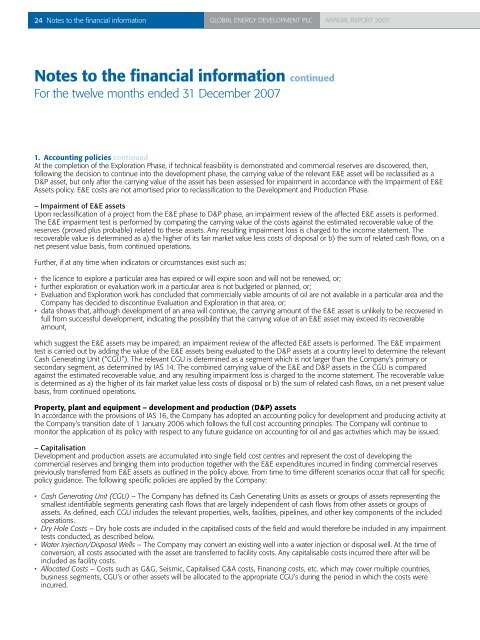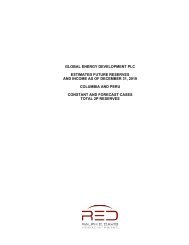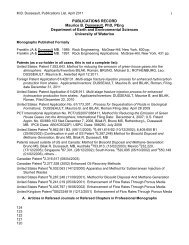Annual Report 2007 - Global Energy Development
Annual Report 2007 - Global Energy Development
Annual Report 2007 - Global Energy Development
- No tags were found...
You also want an ePaper? Increase the reach of your titles
YUMPU automatically turns print PDFs into web optimized ePapers that Google loves.
24 Notes to the financial information <strong>Global</strong> <strong>Energy</strong> <strong>Development</strong> PLC<strong>Annual</strong> report <strong>2007</strong>Notes to the financial information continuedFor the twelve months ended 31 December <strong>2007</strong>1. Accounting policies continuedAt the completion of the Exploration Phase, if technical feasibility is demonstrated and commercial reserves are discovered, then,following the decision to continue into the development phase, the carrying value of the relevant E&E asset will be reclassified as aD&P asset, but only after the carrying value of the asset has been assessed for impairment in accordance with the Impairment of E&EAssets policy. E&E costs are not amortised prior to reclassification to the <strong>Development</strong> and Production Phase.– Impairment of E&E assetsUpon reclassification of a project from the E&E phase to D&P phase, an impairment review of the affected E&E assets is performed.The E&E impairment test is performed by comparing the carrying value of the costs against the estimated recoverable value of thereserves (proved plus probable) related to these assets. Any resulting impairment loss is charged to the income statement. Therecoverable value is determined as a) the higher of its fair market value less costs of disposal or b) the sum of related cash flows, on anet present value basis, from continued operations.Further, if at any time when indicators or circumstances exist such as:••••the licence to explore a particular area has expired or will expire soon and will not be renewed, or;further exploration or evaluation work in a particular area is not budgeted or planned, or;Evaluation and Exploration work has concluded that commercially viable amounts of oil are not available in a particular area and theCompany has decided to discontinue Evaluation and Exploration in that area, or;data shows that, although development of an area will continue, the carrying amount of the E&E asset is unlikely to be recovered infull from successful development, indicating the possibility that the carrying value of an E&E asset may exceed its recoverableamount,which suggest the E&E assets may be impaired; an impairment review of the affected E&E assets is performed. The E&E impairmenttest is carried out by adding the value of the E&E assets being evaluated to the D&P assets at a country level to determine the relevantCash Generating Unit (“CGU”). The relevant CGU is determined as a segment which is not larger than the Company’s primary orsecondary segment, as determined by IAS 14. The combined carrying value of the E&E and D&P assets in the CGU is comparedagainst the estimated recoverable value, and any resulting impairment loss is charged to the income statement. The recoverable valueis determined as a) the higher of its fair market value less costs of disposal or b) the sum of related cash flows, on a net present valuebasis, from continued operations.Property, plant and equipment – development and production (D&P) assetsIn accordance with the provisions of IAS 16, the Company has adopted an accounting policy for development and producing activity atthe Company’s transition date of 1 January 2006 which follows the full cost accounting principles. The Company will continue tomonitor the application of its policy with respect to any future guidance on accounting for oil and gas activities which may be issued.– Capitalisation<strong>Development</strong> and production assets are accumulated into single field cost centres and represent the cost of developing thecommercial reserves and bringing them into production together with the E&E expenditures incurred in finding commercial reservespreviously transferred from E&E assets as outlined in the policy above. From time to time different scenarios occur that call for specificpolicy guidance. The following specific policies are applied by the Company:• Cash Generating Unit (CGU) – The Company has defined its Cash Generating Units as assets or groups of assets representing thesmallest identifiable segments generating cash flows that are largely independent of cash flows from other assets or groups ofassets. As defined, each CGU includes the relevant properties, wells, facilities, pipelines, and other key components of the includedoperations.• Dry Hole Costs – Dry hole costs are included in the capitalised costs of the field and would therefore be included in any impairmenttests conducted, as described below.• Water Injection/Disposal Wells – The Company may convert an existing well into a water injection or disposal well. At the time ofconversion, all costs associated with the asset are transferred to facility costs. Any capitalisable costs incurred there after will beincluded as facility costs.• Allocated Costs – Costs such as G&G, Seismic, Capitalised G&A costs, Financing costs, etc. which may cover multiple countries,business segments, CGU’s or other assets will be allocated to the appropriate CGU’s during the period in which the costs wereincurred.





